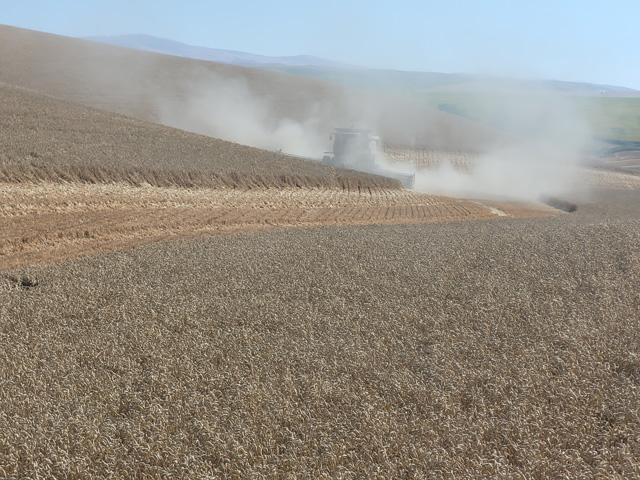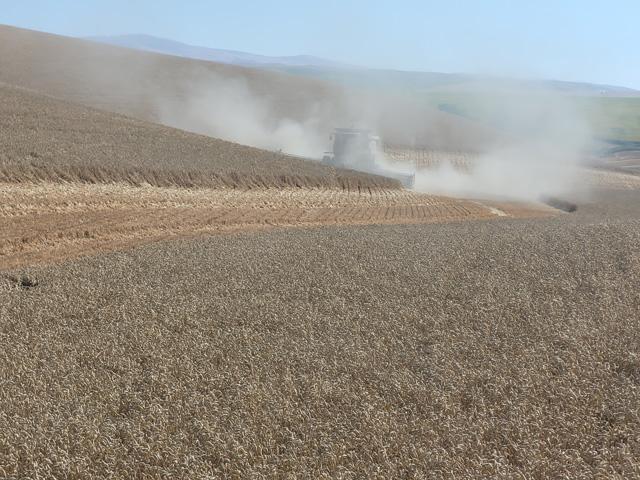Market Matters Blog
US Winter Wheat Harvest Nears Finish Line
The 2022 U.S. winter wheat harvest was 97% complete as of Aug. 22 according to the USDA weekly Crop Progress report, the last week they reported it in their weekly roundup. As of that report, Idaho, Oregon and Montana were still at 85% complete of the 18 reporting states.
In their weekly wheat harvest report, U.S. Wheat Associates said on Sept. 16 that soft white winter wheat (SWW) harvest was winding down under dry conditions and data still reflect low protein, low moisture, and good test weight. "Less than 10% of the Pacific Northwest SWW crop remains as harvest quickly winds down. Good conditions continue for both winter and spring crops in all three states. As winter wheat planting begins, soil moisture is much improved over last fall's seeding condition."
Of the 382 SWW samples tested by USW, the weighted average data is holding steady, with low moisture content at 8.9%, low protein at 9.4% (12% mb moisture basis) and sound falling number value at 339 seconds. Test weight of 61.0 lb per bushel (80.3 kg/hl) and FGIS grading factors are similar to the five-year average.
Art Schultheis, Diamond-S Farms, Inc., Colton, Washington, told DTN, "Yields were better than last year. We were 7" behind normal moisture in 2021 and 4" above normal moisture for 2022. Our average rainfall is 20.64". SWW averaged 107 bushel per acre, which is right on our 10-year average. The re-crop winter wheat yielded just as well as the three-year rotation wheat planted on legume acres. Hard red winter wheat averaged 125 bpa with is above our 10-year average. Still waiting for grades back to see what the protein ended up at. In 2022, we had 650 acres of soft white winter wheat and 270 acres of hard red winter wheat."
Ron Mielke, Harrington, Washington, told DTN they tore out 3,500 acres of their approximately 5,000 acres of SWW because of poor stands influenced by the severe drought and those acres were planted to spring wheat. "The winter wheat that was a good enough stand to take to harvest did average 80 bpa with decent protein." Mielke noted that SWW is most desirable by buyers at 8.5% to 10% and USW reported this year's total crop average came in at 9.4% versus the drought-stricken crop average of 11.3% in 2021.
Mielke said the ideal plant date for their winter wheat is Sept. 1 through Sept. 15. "We drill seed 3 1/2 inches to 4 inches, deep enough to find moisture to start germination, which is still not great for this year because of the 2021 drought. We will plant 5,000 acres of SWW and our planting conditions are far better than 2021 planting season. Between May to June this year, we did receive 2 1/2 inches of rain adding to the seed zone moisture."
SOFT RED WINTER WHEAT
On Aug. 5, 2022, USW released its final soft red winter wheat report. "The lab received and graded all 2022 SRW samples with the final average grade a U.S. No. 2 SRW. Final protein is 9.6% (12% mb). Falling number remains much improved over both last year and the five-year average. Average vomitoxin this year was 0.695 ppm, compared to 0.715 last year."
P[L1] D[0x0] M[300x250] OOP[F] ADUNIT[] T[]
2022 SRW flour is very similar to 2021 with yield, ash, protein and wet gluten all comparable to last year, noted USW. Bread volume is slightly higher this year, but the internal grain and texture score decreased moderately. The overall cookie W/T (W is the average diameter and T the average thickness) average is 10.866 in 2022, compared to 10.672 in 2021. The highest and lowest cookie W/T factors were found in the East Coast states, with the highest in western Maryland (11.4) and the lowest in southeast North Carolina (9.72). Farinograph absorption is slightly lower this year at 51.4% compared to last year's 52.2%.
With high summer temperatures, most of the SRW production region continues to have adequate soil moisture for fall seeding. Here is a link to the entire report: https://www.uswheat.org/…
HARD RED WINTER WHEAT
On Sept. 16, USW reported the final weekly report for the hard red winter wheat crop. As of that date, the average protein came in at 12.9%, moisture was 10.7%, falling number 339 sec, test weight 60.6 lb, damage 0.6%, shrunken and broken 1.0% and total defects were 1.8%, making the 2022 grade a U.S. No. 1 HRW.
The ever-important flour data showed laboratory baking analysis indicating an average loaf volume across all composites of 940 cubic centimeter (cc), above the industry quality target of 850 cc. Farinograph stability over those same composites averaged 9.1 min compared to 9.46 in 2021. As an indicator of quality protein, composites demonstrate exceptionally good water absorption and will deliver quality end-products, reported USW.
In mid-July, in the top production state of Kansas, Justin Gilpin, CEO at Kansas Wheat Commission said, "The Kansas wheat crop looks to be a very favorable, marketable crop with test weights above 60 pounds per bushel, with stronger numbers early before recent rains, and some sub-60-pound test weights afterward. Proteins look to be averaging a little better than 12%, with some 11%, 12%, 13%, and some extremes."
In much of South Dakota, the hard red winter wheat crop was high test weight and protein and graded No. 1 HRW wheat. Tim Luken, manager Oahe Grain, Onida, South Dakota, told DTN, "This year growing season was great. Winter wheat came in over the winter with no issues at all and we received good rains this spring to get the crop off to a great start. Yields were very good and our final average for this year's crop was 62.1 lb, 13.2% protein 11.0% moisture and falling numbers at 350-380 and with .5 or less vomitoxin. The mills should be happy even with the high protein."
A farmer in eastern Montana told DTN on Sept. 13, "Winter wheat around here was real scarce. If our weather stays like we are now for another 10-15 days, there will be even less for 2023."
The variation in protein in the HRW wheat crop, with the final U.S. average at 12.9%, has mills favoring the lower protein for blending. Flour mills make a 13% protein flour, while the most common is a "mid-mix," 12% protein flour. One thing to note is that 1% of the wheat protein is lost in the flour-making process.
USDA NASS report on Aug. 12 noted that winter wheat production was forecast at 1.20 billion bushels (bb), down less than 1% from the July 1 forecast and down 6% from 2021. As of Aug. 1, the United States yield is forecast at 47.9 bushels per acre (bpa), down 2.3 bushels from last year's average yield of 50.2 bpa. Hard Red Winter production, at 576 million bushels (mb), is down 2% from July. Soft red winter, at 381 mb, is up 2% from the July forecast. White winter, at 240 mb, is up slightly from July. Of the white winter production, 14.6 mb are hard white and 226 mb are soft white.
On Sept. 30, USDA will publish the Small Grains Annual Summary which presents data on the acreage, area planted and harvested, yield and production of wheat, oats, barley, and rye, by state and U.S. and also wheat production by class.
Link to wheat testing terminology: https://wmcinc.org/…
Mary Kennedy can be reached at Mary.Kennedy@dtn.com
Follow her on Twitter @MaryCKenn
(c) Copyright 2022 DTN, LLC. All rights reserved.






Comments
To comment, please Log In or Join our Community .